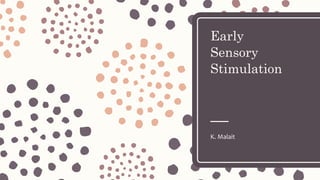
Early Sensory Stimulation
- 2. Sensory stimulation is the impact the environment has on our minds and bodies as we receive information through our five senses. Early sensory stimulation is vital in a child’s brain development and his capacity for early learning. The amount of stimulation received by a child is said to have an effect on his growth and development, supporting the idea that sensory enrichment can improve a child's weight gain, sensory functioning, and nervous system organization.
- 3. Stimulating a child’s senses allows the brain to develop more rapidly and extensively. Early sensory stimulation will provide the child a developmental advantage over other children of the same age or level in more than 85% of cases. According to numerous clinical studies, early-developed children tend to do better at school, integrate relationships better and are, generally, better adjusted. Likewise, according to a study by Prof. Larry Lynch, teachers of both preschool and grade school levels observed a remarkably higher level of social and educational integration among children who have experienced proper early sensory stimulation.
- 4. Physical Stimuli and the Senses
- 5. Visual Perception • Children, most prominently infants, prefer looking at people rather than things. • They can focus and follow slow-moving objects. • They can distinguish shapes and forms.
- 6. Auditory Perception • Very young children can recognize and discriminate sounds. • Talking, singing and humming are effective ways to enrich their auditory stimulation. • Babies are sensitive to harsh sounds as their auditory perception is already sensitive even before they were born.
- 7. • Perception of Taste • Perception of Smell • Skin Senses
- 8. Parents who hope to promote and hasten the mental and sensory development of their children can make use of games and sensory playing. Sensory activities and sensory tables enable and improve the sense of exploration and naturally encourage children to utilize scientific processes while they play, create, investigate and explore. Investing time in stimulating their senses allows children to develop cognitive, linguistic, social and emotional, as well as physical and creative abilities.
- 9. Language Acquisition through Early Sensory Stimulation While very young children may not yet have the capability to conjure up words to describe their experiences and emotions, sensory play can help them develop vocabulary and understand language. By using words and questions that pertain to the child’s experience, parents and caregivers can link sensory experiences with cognitive growth.
- 10. Touch: “I’m pouring warm water on your head. Do you feel the wet water?” Sight: “Do you see the bird on the fence?”, “Where do you see a squirrel?” Smell: “Would you like to smell this flower?”, “Can you smell this soap?” Taste: “How does the lemon taste? Is it sour?”, “Is that cupcake sweet?” Sound: “Do you hear the airplane? What sound does it make?”
- 11. Factors Affecting Early Sensory Stimulation • Developmental considerations • Culture • Personality and lifestyle • Stress • Illness and Medication
- 12. Developmental considerations Includes the child’s need for rocking, holding and changes in positions, variations in pattern of light and shade, as well as being sang and talked to. Appropriate sensory play develops muscles and coordination. It also provides an outlet for the child’s physical energy while developing his communication skills.
- 13. Culture In some cultures, male and female roles may be specifically defined. Ethnic norms, religious norms, income group norms, and norms of subgroups may also influence the amount of stimulation and perception that can be developed by the child.
- 14. Personality and Lifestyle Choices can dramatically influence quantity and quality of stimuli received. e.g.: A child who lives in a smaller, more sophisticated community is exposed to different stimuli than a child who lives in a larger, less organized setting.
- 16. Sensory Alterations • Sensory Deprivation • Sensory Overload • Cultural Care Deprivation • Sensory Deficits
- 17. Sensory Deprivation This results from: • Decreased sensory input • Isolation • Impaired ability to receive environmental stimuli • Inability to process environmental stimuli (e.g., brain injury, side effects of medications)
- 18. Sensory Overload This happens when a person experiences so much the brain is unable to respond meaningfully. In other words, the brain is receiving much more stimuli than it can actually manage. This results to: • Unrealistic perceptions, ineffective coping capability • Bewilderment, disorientation, difficulty in concentrating, and muscle tension • Reduced problem-solving ability, scattered attention, racing thoughts
- 19. Sensory Deficits This pertains to the impairment of perception, reception, or both of the senses (e.g., blindness, deafness, loss of sense of taste). The tendency of one sense is to be more acute or active in order to compensate for the deficit. This puts the child at risk of sensory overload.
- 20. Symptoms and Effects of Sensory Deficit are as follows: • Decreased attention span and difficulty concentrating • Impaired memory • Disorientation, confusion, possible hallucinations • Crying and annoyance over small matters • Depression • Apathy, constant boredom, and anger
- 21. Cultural Care Deprivation This pertains to the lack of culturally assistive, supportive, or facilitative acts. It is the absence of certain expected and acceptable cultural phenomena in the environment which results in the failure of the individual to communicate and respond in the most appropriate manner within the context of society.
